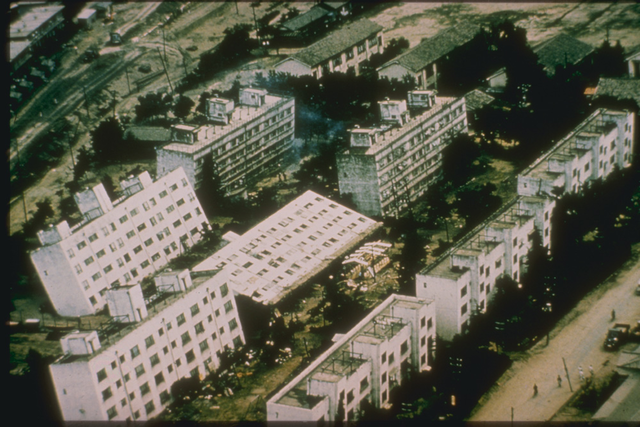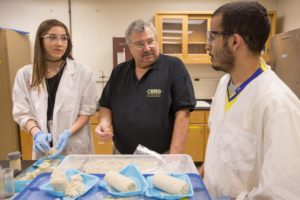
Helping to fortify defenses against an earth-shaking problem

Soil liquefaction resulting from earthquakes can dramatically increase the severity of damage done by major seismic events. An Arizona State University geotechnical engineer worked with the National Academies of Science, Engineering, and Medicine to recently produce guidelines to cope with the threat of liquefaction. Photograph courtesy of the National Geophysical Data Center.
In 2011 a powerful earthquake that hit Christchurch, New Zealand, the country’s second-largest city, resulted in massive damage, especially for a quake that registered a relatively modest 6.3 on the Richter scale.
Many buildings collapsed, road surfaces cracked, bridges buckled, water and sand that burst up from the ground caused substantial flooding. Nearly 200 people died as a result.
More than 100,000 modern, single-family homes were damaged and as many as 15,000 had to be abandoned and demolished.
The government later estimated that the cost to completely rebuild after the earthquake could rise to about $40 billion. Some economists estimate it will take more than 50 years for full economic recovery.
The prime culprit responsible for the severe impact of the earthquake was a process called liquefaction. It occurs when loose, water-saturated soil at or near the ground surface loses its strength when the ground experiences strong shaking.
Liquefaction and its destructive potential is a fairly widespread threat.
“There is literally trillions of dollars’ worth of infrastructure around the world on ground that is at risk of liquefaction,” says Edward Kavazanjian, a Regents’ Professor and the Ira A. Fulton Professor of Geotechnical Engineering at Arizona State University’s Ira A. Fulton Schools of Engineering.
The U.S. Geological Survey estimates that 40 percent of the United States is subject to ground motions severe enough to cause liquefaction sufficient to damage infrastructure.
Kavazanjian called on to take key position
The Christchurch quake was one of several big natural disasters that prompted the Earthquake Engineering Research Institute, an international technical and professional society, to call for an extensive study of methods to better determine soil liquefaction risks and deal with its consequences.
The EERI committee that recommended the study also recommended it be conducted by the National Academies for Science, Engineering, and Medicine, given the importance of its goal.
The National Academies’ Committee on Geological and Geotechnical Engineering was tasked with raising the money for the study and commissioning an ad hoc committee to conduct the study and write the report. Kavazanjian was the committee’s chair at the time and worked with National Academy staff to raise the approximately $1 million necessary for the study from a variety of stakeholders.
Once funds were raised, nominations were solicited for study committee members through a variety of channels, including the National Academies and the study’s sponsors. From those nominations, a group of 11 engineers and scientists whose combined expertise covered the spectrum of disciplines considered necessary for the study was selected.
Kavazanjian’s term as chair of the National Academy’s engineering committee ended by the time the funding was secured, but he then was asked to chair the ad hoc committee that conducted the study and wrote the report.
New guidelines getting debut before stakeholders
Now, five years after fund raising began and three years after initiation of the study, the “State of the Art and Practice in the Assessment of Earthquake-Induced Soil Liquefaction” has been released.

The Center for Bio-mediated and Bio-inspired Geotechnics at Arizona State University, directed by Professor Edward Kavazanjian (center), is developing new technologies and methods to help mitigate damage caused by soil liquefaction and similar problems. Photographer: Jessica Hochreiter/ASU
“We have conducted a comprehensive study that tells you the best practices that the experts know of to assess what is likely to happen if liquefaction occurs and to guide decisions on what to do in the way of prevention, mitigation and remediation,” Kavazanjian says.
Now he will be among the contingent of study committee representatives to lead presentations and workshops to introduce the report to major stakeholders around the country.
The events include an open session at the February meeting of the Committee on Geological and Geotechnical Engineering in Irvine, California, and a breakout session in early March at the Earthquake Engineering Research Institute annual meeting in Portland, Oregon, and later in March at a featured session at the 2017 annual Geo-Congress of the Geo-Institute of the American Society of Civil Engineers at the international Geotechnical Frontiers conference in Orlando, Florida.
“We’re expecting standing-room-only crowds,” Kavazanjian says.
Study passed thorough peer-review test
The importance of the study’s conclusions to industry and government agencies is reflected by the list of sponsors that funded the project. Those are the Nuclear Regulatory Commission, the U.S. Bureau of Reclamation, the Ports of Long Beach and Los Angeles, the American Society of Civil Engineers and the Federal Highway Administration.
“There was substantial contribution from groups that had never before helped to fund a national study like this,” Kavazanjian says. “That’s because this is something with a potentially big impact on major business and economic interests, as well as public safety.”
For example, coastal Southern California, which includes the two major ports in Los Angeles and Long Beach, as well as other critical infrastructure — not to mention the region’s broad swaths of high-priced real estate — is among places most at risk of liquefaction.
Kavazanjian says completing the report has been a challenge because the authors ultimately had to accommodate the viewpoints of differing schools of thought on the optimal methods to address assessment of the potential for liquefaction and the consequences of its occurrence.
He believes the study will nevertheless be well received by stakeholders despite the inevitable debates over some of its content.
“The 11-person study committee had to reach consensus on its recommendations, which were then subject to a high-level of peer review in accordance with National Academies policy,” he says.
ASU research center poised to contribute to future advances
Still, one conclusion of the report is that there is much more to learn about coping with liquefaction.
To answer all the questions on the subject, Kavazanjian says, “We need much more field data on how liquefaction interacts with structures. We need liquefaction observatories to study at-risk sites. We basically need to instrument some sites and then wait for an earthquake to happen at one of those locations. It could take 20 to 30 years to get all the data we need.”
While the report addresses the consequences of liquefaction, it stopped short of addressing how to mitigate those consequences. Some of the answers on how to do that will likely come from Kavazanjian’s work as director of the Center for Bio-mediated and Bio-inspired Geotechnics, a National Science Foundation Engineering Research Center led by ASU.
“Right now there are no cost-effective ways to remediate potentially liquefiable soil under and adjacent to existing buildings and infrastructure. That’s a big national and international problem,” he says. “It’s one of the big things we want to make possible with the technologies we are developing at CBBG.”



































